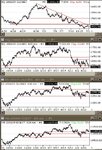Charts from posting #3
I had been working on an analysis of the charts from post #3, when I was disheartened to see that firewalker had already posted an analysis. On closer inspection, it seem he has analyzed the charts from #4, so it all worked out for the best.
7/11/2006
Context (first chart): Comparing this "context panel" of charts with the panel from the previous day, it's clear that the NQ not only does not have the same buffer as the ES and YM between the current price and lows formed in mid-October, but the previous day has accentuated this difference. The NQ begins the day barely above support formed by these lows and tested in early June. In contrast, ES and YM, which also saw prices fall the previous day, have held above congestion areas which formed in mid-June -- obviously not the case with NQ.
Some trading days seem to begin with a question that needs answering. In the case of the NQ, the daily chart highlights that price is at the extreme lower right corner formed by (a) the supply line descending from the high of 6/30 and (b) the strong support level (1526, approximately) prominent on the longer term chart. Today's question appears to be whether prices will break down through this support level or break up through the two-week-old supply line. It's decision day.
Previous Day (second chart): As the market opens, price is between the PDL (about 1526, marked as a S/R level) and the PDC (1534, which is also marked, and comprised support during the early afternoon of the previous day). Also marked as key S/R levels are 1540, the support level visible on the daily chart through which price penetrated the previous day, and 1538, which was the overnight high (and which also formed the lower boundary of the congestion zone just below 1540).
Opening (third chart): The opening is volatile (compare bar lengths with those from the previous afternoon), but that's normal. Generally, price remains within the confines of the S/R levels at 1532 and 1526. The first bar plunges from 1532 to just over 1528, where price consolidated just before and after making the daily low the previous day.
After stalling at +/- 1528, price then tests the opening bar's high, is forced briefly down to just above the level where it had just stalled (1529), then consolidates for several bars between 1531 and 1532. When no further upward progress can be made at this level, sellers gain the upper hand and push price down nearly to the PDL. But take a look at the bar lengths just preceding this low: price inches down with each bar, barely making any progress, like a spring being loaded (it would be particularly interesting to see the volume that accompanied these bars to get some sense of the support offered as price approached the low).
Then, suddenly, the spring is released, and price shoots up to around 1531.5 where sellers decisively turn back the advance. Why here? We see that, the previous day, this level acted as support then resistance as price moved down to the PDL, and resistance then support on the way back up. This level's importance is confirmed today as price finds sufficent selling pressure here to be turned back again (this is the justification for drawing in the new S/R line), to 1529, where it again finds support.
The result of the opening price action has been to delineate some S/R levels but, at this point, price is pretty much centered between those levels, and no sustained directional movement has been achieved.


















